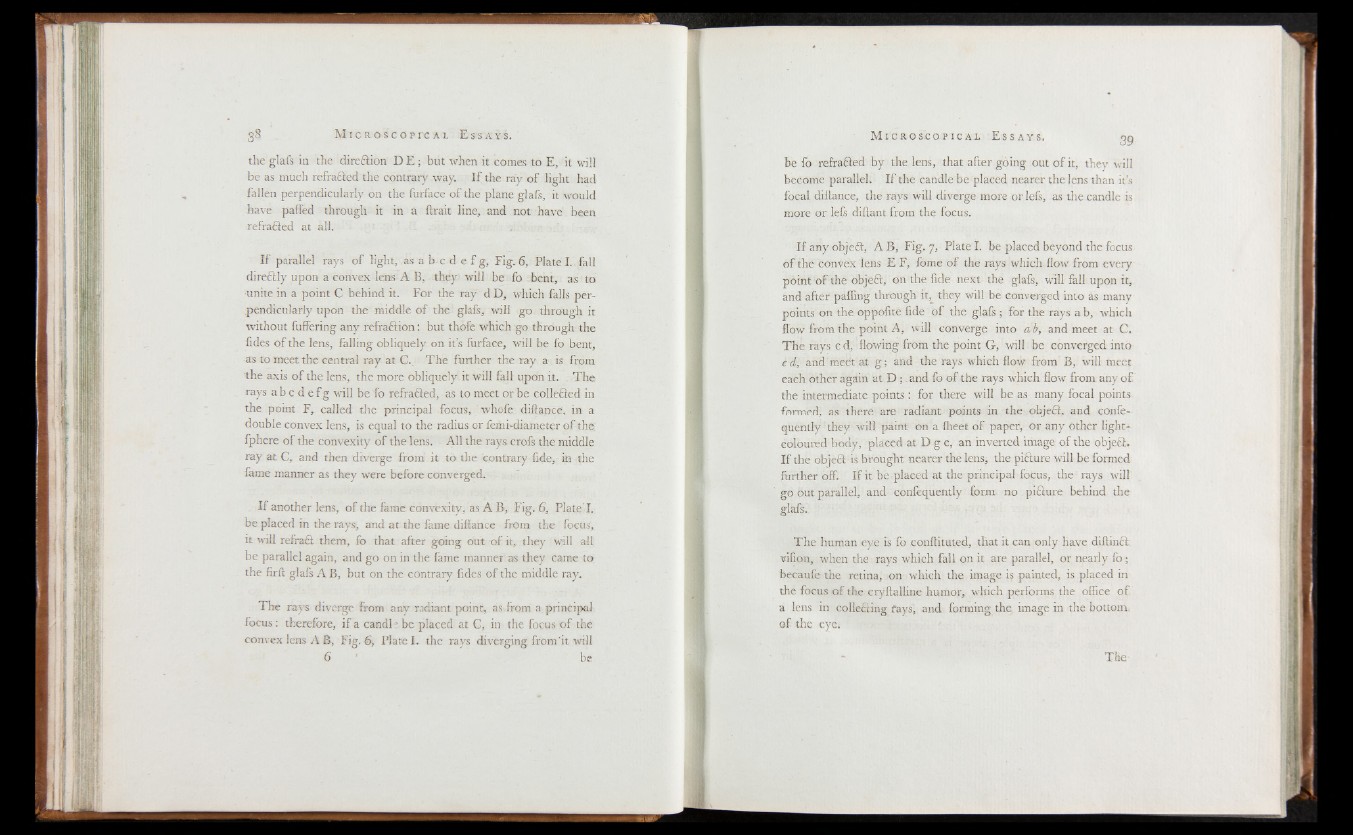
33
the glafs in the direction D E ; but when it comes to E, it will
be as much refrafted the contrary way. I f the ray of light had
fallen perpendicularly on the furface of the plane glafs, it would
have paffed through it in a ftrait line, and not have been
refraCted at all. ;
I f parallel rays o f light, as a b e d e f g, Fig. 6, Plate!, fall
direCtly upon a convex lens A B, they will be fo bent, as to
unite in a point C behind it. For the ray d D, which falls perpendicularly
upon the middle o f the glafs, will go through it
without fuffering any_refraftion: but thofe which go through the
fides o f the lens, falling obliquely on it’s furface, will be fo bent,
as to meet the central ray at C.. The further the ray a is from
the axis o f the lens, the more obliquely it will fall upon it. The
rays ab c d e f g will be fo refrafted, as to meet or be colleCled in
the point F, called the principal focus, whofe diftance, in a
double convex lens, is equal to the radius or femi-diameter o f the
fphere o f the convexity o f the lens. All the rays crofs the middle
ray at C, and then diverge from it to the contrary fide, in the
lame manner as they were before converged.
I f another lens, o f the fame convexity, as A B, Fig. 6, PI ate I.
be placed in the rays-, and at the fame diftance from the focus,
it will refract them, fo that after going out of it, they will all
be parallel again, and go on in the fame manner as they came to
the firft glafs A B, but on the contrary fides o f the middle ray.
The rays diverge from any radiant point, as from a principal
focus: therefore, if a candle be placed at C, in the focus o f the
convex lens A B, Fig. 6-, Plate I. the rays diverging from'it will
6 ' be
be lo refrafted by the lens, that after going out of it, they will
become parallel. I f the candle be placed nearer the lens than it’s
focal diftance, the rays will diverge more or lefs, as the candle is
more or lefs diftant from the focus.
I f any objeft, A B , Fig. 7, Plate I. be placed beyond the focus
o f the convex lens E F, feme of the rays which flow from every
point o f the objeft, on the fide next the glafs, will fall upon it,
and after paffing through it^ they will be converged into as many
points on the oppofite fide o f the glafs ; for the rays a b, which
flow from the point A, will converge into ab, and meet at C.
The rays c d, flowing from the point G, will be converged into
e d, and meet at g ; and the rays which flow from B, will meet
each other again at D ; and fo o f the rays which flow from any of:
the intermediate points : for there will be as many focal points
formed, as there are radiant points in the objeft, and confe-
quently they will paint on a fheet o f paper, or any other light-
coloured body, placed at D g c, an inverted image of the objeft.
I f the objeft is brought nearer the lens, the pifture will be formed
further off. I f it be placed at the principal focus, the rays will
go out parallel, and confequently form no pifture behind the
glafs.
The human eye is fo conftituted, that it can only have diftinft:
vifion, when the rays which fall on it are parallel, or nearly fo ;
becaufe the retina, on which the image is painted, is placed in
the focus o f the cryftalline humor, which performs the office o f
a lens in collefting fays, and forming the image in the bottom,
o f the eye;